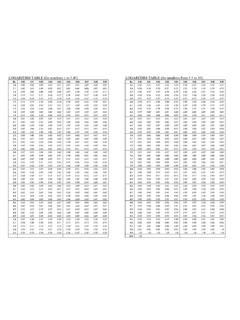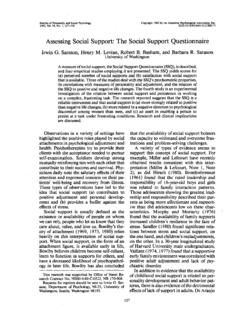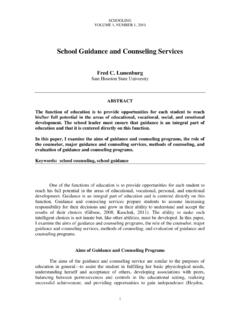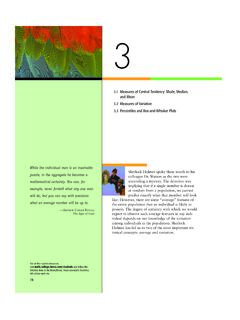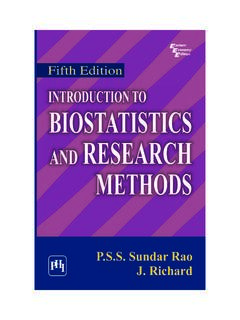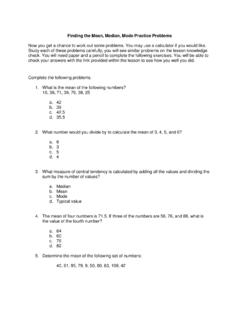Transcription of Unit 3: Data representation - WikiEducator
1 Module 6: Unit 3 Data representation57 Unit 3: Data representationIntroduction to Unit 3In this unit you will look at different ways to represent data in tables, charts,graphs and diagrams. The emphasis is not on the techniques to produce theserepresentations, but on the question of whether or not the representation bestrepresents the of Unit 3 The aim of this unit is to look at a variety of ways to represent data and tocompare these for the best representation of the data given. The unit willlook at : frequency tables, pictograms, bar charts, line bar charts, histograms,pie charts, line graphs, frequency polygons, stem-leaf plots, scatter the end of this unit you should be able to: organise data describe data read and interpret displays of data construct appropriate displays of data: frequency table, pictogram, barchart, line bar chart, histogram, pie chart, line graph, frequency polygon,stem-leaf plots, scatter plots justify the choice of display used for given data critically analyse data displays state common pupil errors in data representation illustrate methods to misrepresent data use appropriate project work in the classroom to assist the pupils in theirlearning of data representationTimeTo study this unit will take you about 10 6.
2 Unit 3 Data representation58 Unit 3: Data representationSection A: Represent or model dataWhat is the best way to represent the collected data? Is the data discrete orcontinuous, is the data qualitative or quantitative, how does one change fromone form of representation to another, what is the effect of changing scale?These are questions to be considered. Too frequently the emphasis is onoperational understanding, on the techniques of drawing a bar chart, a piechart, a cumulative frequency curve while questions as to why to use the(most of the time) stated representation in the given circumstances (are theyvalid? are they appropriate?) are hardly considered. It should be left to thepupils to decide what is the most appropriate way to represent their data (andthat is the difficult part the actual drawing of chart is not the problem ingeneral, and could be done by a computer).
3 One way to do this is bycomparing different forms of representing the displays should: show the data induce the viewer to think about substance rather than aboutmethodology represent large data sets in a relatively small space make large data sets coherent encourage pupils to make comparisons between different pieces of data reveal the data at several levels of detail serve a reasonably clear purpose be integrated with the statistical and verbal descriptions of the dataSection B: TablesData collected is generally first tabulated in frequency distribution tables might contain data that is grouped or ungrouped. Sometimestwo-way tables are were covered in the previous Unit 2, section C: Nature and format of dataThe type of representation that can be used depends ona) the nature of the data, , discrete or continuous datab) the format in which the data is given ungrouped or groupedDiscrete dataDiscrete data can be displayed in bar charts (categorical data), bar-linegraphs (discrete quantitative data) or pie charts (categorical data / discretequantitative, provided the number of categories or discrete values is notlarge).
4 Module 6: Unit 3 Data representation59In a bar graph or bar-line graph the height of the bar or line is proportionalto the are to be drawn separated equally, with same width. The discrete valueor category is placed at the centre of the bar. The frequencies, along thevertical axis, are placed against the lines (NOT the spaces). Bar-line graphsare very appropriate with discrete data (number of children in the family,shoe size of pupils, etc.), bar graphs (also called frequency diagrams) aremore appropriate for grouped discrete data or for categorical a pie chart the angle at the centre of each sector is proportional to thefrequency. Therefore the radius of the pie chart is not relevant. The numberof sectors should, generally, not exceed 6 - 8 to make the presentationmeaningful and allow comparison between the various dataContinuous data is best displayed in histograms.
5 In a histogram thefrequencies are proportional to the area of the bar. In cases where bars of thesame width are considered the histogram becomes a bar graph, but the barstouch each other. Details will be discussed It is rather common to display certain discrete data (for example, scoreson a test, number of children in a family, , numerical data that can beordered) in a bar graph with the bars touching each other. This is strictlyspeaking not correct, but you should not try to make the distinction withstudents of this vs. dependent variablesAn independent variable is presumed to have an effect on another is the variable that is manipulated or changed by the researcher toinvestigate the effect on a dependent variable. It is also known as themanipulated or experimental variable that we have discussed above.
6 Theeffect of the manipulation is observed on the dependent variable. Theindependent variable is a variable that by itself does not necessarily give riseto the behaviour of interest except if dependent (or outcome) variable is that variable which occurrence orfrequency of occurrence depends on the conditions and the manipulation ofthe independent variable. It is called the dependent variable because its valuedepends on and varies with the value of the independent independent variable is commonly plotted along the horizontal axis andthe dependent variable along the vertical down the different data representations (charts, graphs, diagrams) What type of data is most appropriately represented by each of therepresentations you listed above?2 What type of data cannot be represented by each of the representationsyou listed?
7 Module 6: Unit 3 Data representation60 Section D: Graphical representationsData can be represented in various ways, and in the following sections youare going to look at the following representations of data. Bar charts (Section D1) Line/stick graphs (Section D2) Histograms (Section D3) Pie charts (Section D4) Pictograms (Section D5) Line graphs/charts (Section D6) Frequency polygons (Section D7) Stem-leaf diagrams (Section D8) Scatter diagram (Section D9)In each section special attention will be given to the type of data that can berepresented in that particular D1: Bar charts (bars horizontal or vertical)Most appropriate use: to compare categories (qualitative data, theindependent variable is non-numerical) and grouped discrete quantitativedata (scores on a test, amount spend by customers in a shop)How to draw: Rectangles with equal width are used.
8 The height/lengthrepresents the frequency of the category. Do not draw the bar adjacent. Labelthe diagram as a whole (title), the bars and the frequency axis. Indicate scaleon the frequency of qualitative data displayModule 6: Unit 3 Data representation61 Examples of quantitative discrete (grouped) data of customers in a groupModule 6: Unit 3 Data representation62 Section D2: Line/stick graphs(can be horizontally or vertically displayed)Most appropriate use: to compare discrete variablesHow to draw: lines/sticks of length proportional to the with the bar D3: HistogramsMost appropriate use: to represent grouped continuous variables. Alwaysdepicts frequency (or count) versus a continuous or nearly to draw: Rectangles whose areas are proportional to the rectangles are adjacent (that is, the rectangles touch each other.)
9 Theaxes are labelled, the graph has a : The height of 100 maize plants was measured, to the nearest cm,one month after of maize plants Frequency Frequency density1 - 20 - 40 - 60 - 70 6: Unit 3 Data (i) Different notations for the classes are in use, 1 - 20 standing forheights from 1 to 20 both inclusive in the above case. Also thenotation [1, 20] or 1 height 20 can be books use as the first class 0 - 20 to mean 0 height < 20 andwrite the next class as 20 - 40 to imply 20 height < 40, etc. Thenotation to be used is a matter of agreement.(ii)Attention is to be paid to the upper and lower boundaries. Thecontext dictates how they have to be the above example of measurements to the nearest cm, theboundaries are half way between two classes. The rectangles are tobe drawn in the above example from (the lower boundary) (the upper boundary), from to and the last one to In case the variable is age (a continuous variable) the situation isdifferent.
10 Ages are given in completed years, not to the nearest person of 20 years and 11 months and 25 days is still considered tobe 20. Consider the following ages of applicants for a teaching post have the Frequency20 - 24 425 - 29 230 - 34 235 - 44 2In the class 20 - 24 fall all applicants with age 20 age < 25, in theclass 25 - 29 fall all applicants with ages 25 age < 30, etc. The classboundaries are 20, 25, 30, 35, 6: Unit 3 Data representation64(iii) The frequency density is the frequency divided by the class width(upper boundary lower boundary of the class). This is a fine point,probably one that you should not teach.(iv) In cases that classes have all the same width, the frequency densityand frequency are directly proportional and some authors will labelthe axis: frequencies in that case.(v) Discrete grouped data (test scores, amount of money spent in a shop)should be displayed in bar graphs.

